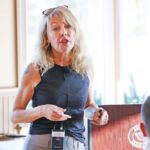Unwritten, The Story of a Living System

Unwritten, The Story of a Living System: A Pathway to Enlivening and Transforming Education
by: Lori L. Desautels, Ph.D. and Michael McKnight, M.A.
Published by Wyatt-MacKenzie
Umbutu-“I am because you are”
Available at Amazon.com and Barnes & Noble
An Introduction
We cannot remember a more chaotic and tenuous time in our nation’s educational story. We are closing and opening schools, increasing the amount and intensity of standardized tests, changing education standards, starting more charter schools, magnet schools, and school choice programs. We are creating additional and elaborate teacher and administrator evaluation systems tied to achievement testing as well as “best practice” rubrics. We are changing school schedules, increasing the amount of time we teach certain subjects, and experimenting with year round schooling. We are increasing the use of technology throughout the system, and despite all these efforts, there remains a sense that something is not quite right with our educational system. Quite possibly, for reasons we are not addressing, our schools are not working.
If we step back and widen our view, there are many countries throughout our planet that are attempting to “reform” their educational system. It has become a global concern.
Beneath all the tinkering that is being conducted around the globe, and particularly in our country, a worldview exists that sees our educational system as a predictable and manageable machine.
This machine can be controlled by providing certain “inputs” in the form of curriculum, topics and core subjects, and by measuring “outputs” with additional assessments and testing. It is a worldview that is deeply embedded in how we perceive the world we inhabit. This perception of the world as a machine has influenced our thinking and the ways we initiate “how” to solve these problems. This perception shapes our institutions and our behaviors even if we are not aware of it. In our schools this worldview is based on finding and fixing deficits in our young people. Rarely do schools look and see “whole children.” We have continued to focus all our “reform initiatives” on the peripheral fixes that have not and will not transform the current system. Why is this the case?
Could this worldview of fixing and remediating that we have focused upon be based on an illusion? It does not feel real or accurate. It has many of us looking at our schools as factories and our young people as “pieces” moving along assembly lines. It only sees “external” structures and does not see beneath human behavior.
Learning is the most natural thing human beings do. Yet, it seems the “harder” we work in schools helping our students acquire the learning they need, the academic performances stay stagnant or lessen.
Schools are not machines. Schools are a network of human beings who feel, think, behave, and function within a human system that is alive and never static. Schools are living systems! This living system of sentient beings are neurobiologically wired to feel first, then to think, to love, to connect, and to experience deep joy as well as deep disappointment and pain. This system is wired to thrive, even through difficult times. Have we lost our way through the primordial landscape of our innate purpose and genius? We can begin to think and to feel differently. Deep learning is profoundly relational, and connection to one another is a prerequisite for our collective emotional, social, spiritual, and cognitive growth and development.
Our current story is rooted in scarcity and deficiency. This mindset leads to a prescriptive standardized process and structure of schooling that strikingly looks and feels the same all over America. Many of our children are not learning in this environment. Many children are dropping out of this system, and in many places, half of our students leave before graduating. One has to wonder why so many of our young people leave an institution that is supposed to benefit their lives? Students either formally leave by dropping out, or cognitively check out as they sit before us in our classrooms. At the same time, we are also witnessing an ever-increasing tendency toward violence in our children. Our children are literally killing each other at younger and younger ages.
Programs do not change people. People change people. It is critical to remember that the schools we are working within consist of webs of relationships. The schools we work in are alive! Transformation within any living system cannot be externally mandated or directed. It can only be provoked. If we are to intimately connect to the hearts and minds of one another, change must come from within. We can create generative learning environments that invite learning that increases our capacity for continuous growth and development throughout our entire life span. This will require a new way of looking at the world.
Deep learning in human beings is profoundly relational. Close connections and attachment to supportive adults is a prerequisite to learning from them. Michael and I hope to disturb your thinking gently—gently enough to have you consider that your role as an educator is moving in a new direction inside a story that embraces the teaching and learning process that is organically alive, that inhales and exhales, that moves and grows within an adaptive messy context of a living system.
Please join us in dialogue as we question, remember, strategize, and rewrite the story. The story of a living system that knows compassion, that feels the joys and suffering of humankind, but oftentimes, loses its way in an industrial robotic environment where people are unable to thrive.
We have created a format for reading and digesting the content inside this book. We hope to bring these ideas to life by presenting specific teaching principles and strategies designed, not only to engage the students’ intellect, but to trigger an emotional and relational link to their teachers and classmates, as well.
Within each chapter, we have included a quote, the content topics interspersed with a dialogue between the two of us. As we wrote this story, we discussed, questioned and shared our thoughts. It is our hope that in the ways this story was created, you too will benefit from this book’s dialogue and actionable “sparks” at the end of each chapter. The teaching sparks are strategies that are aligned to the topics in each section. We entitled these as “sparks” to ignite your enthusiasm, while providing you with resources to assist you in your current educational practices. Michael and I understand what the research reports. “We learn deeply when we teach others.” As we write, we also learn. We are not the experts, but we share your passion and questions about how to enliven and improve this current, beautifully complex, living system.




